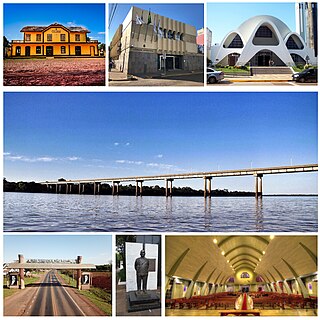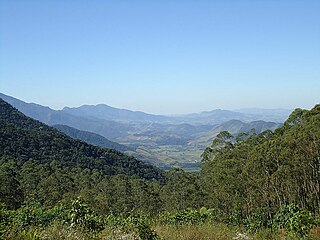Related Research Articles

Rio Grande do Sul is a state in the southern region of Brazil. It is the fifth-most populous state and the ninth-largest by area. Located in the southernmost part of the country, Rio Grande do Sul is bordered clockwise by Santa Catarina to the north and northeast, the Atlantic Ocean to the east, the Uruguayan departments of Rocha, Treinta y Tres, Cerro Largo, Rivera, and Artigas to the south and southwest, and the Argentine provinces of Corrientes and Misiones to the west and northwest. The capital and largest city is Porto Alegre. The state has the highest life expectancy in Brazil, and the crime rate is relatively low compared to the Brazilian national average. Despite the high standard of living, unemployment is still high in the state, as of 2017. The state has 5.4% of the Brazilian population and it is responsible for 6.6% of the Brazilian GDP.

São Borja is a city in the Brazilian state of Rio Grande do Sul. São Borja is the oldest municipality in the Brazilian state of Rio Grande do Sul and was founded in 1682 by the Jesuits as the first of the Seven Points of the Missions, and named São Francisco de Borja, in honor of Saint Francis Borgia.

Aguaí is a Brazilian municipality located in the eastern part of the state of São Paulo. The population is 36,648 in an area of 475 square kilometres (183 sq mi). The settlement Cascavel was established in 1887 near a railway station. In 1944, when it was separated from São João da Boa Vista, it became an independent municipality with the name Aguaí.

Igaratá is a municipality in the state of São Paulo in Brazil. It is part of the Metropolitan Region of Vale do Paraíba e Litoral Norte. The population is 9,583 in an area of 292.95 km². The elevation is 745 m. This place name comes from the Tupi language.

The Mantiqueira Mountains are a mountain range in Southeastern Brazil, with parts in the states of São Paulo, Minas Gerais and Rio de Janeiro. It rises abruptly from the northwestern bank of the Paraíba do Sul River and extends northeastward for approximately 320 km (200 mi), reaching a height of 2,798 m (9,180 ft) at Pedra da Mina. The mountains, which eventually merge with the Serra do Espinhaço, were originally forest-covered, except for the peaks that rise above the tree line. They provide charcoal and pasture for cattle; on the lower slopes there are several health and tourist resorts, such as Campos do Jordão, Brazil's highest city. The name Mantiqueira derives from a Tupi word meaning "mountains that cry", denoting the large number of springs and streams found there.

Polish Brazilians refers to Brazilians of full or partial Polish ancestry who are aware of such ancestry and remain connected, to some degree, to Polish culture, or Polish-born people permanently residing in Brazil. Also, a Polish Brazilian may have one Polish parent.

Vargem Grande do Sul is a municipality in the northeast of the state of São Paulo in Brazil. The population is 43,110 in an area of 267 km². The elevation is 721 m. Access through state roads SP-344 and SP-215. Human Development Index is 0.802.

Santiago is a municipality of the western part of the state of Rio Grande do Sul, Brazil. It is the capital of the microregion of Santiago. The population is 49,360 in an area of 2,413.13 km2 (931.71 sq mi). Its elevation is 409 m. It is located 450 km west of the state capital of Porto Alegre and northeast of Alegrete. The nickname of the city is "The Land of the Poets".

São Francisco de Assis is a Brazilian municipality in the western part of the state of Rio Grande do Sul. It has a population of 18,205 (2020). Its elevation is 151 m. It has an area of 2,530.9 km². It is located 434 km west of the state capital of Porto Alegre. The nickname of the city is Sao Chico.

Jaguari is a municipality in the state of Rio Grande do Sul, Brazil.
The Jaguari River is a river of São Paulo state in southeastern Brazil. It is a tributary of the Paraíba do Sul.
The Jaguari River is a river in the state of Rio Grande do Sul in southern Brazil. It is a tributary of the Canastra River, and therefore indirectly of the Caí River.
Jaguari is a municipality in the state Rio Grande do Sul, Brazil.

The Mantiqueira Mosaic is a protected area mosaic that contains conservation units in the states of Rio de Janeiro, São Paulo and Minas Gerais, Brazil. The conservation units are of different types and are managed at the federal, state or municipal level. The mosaic provides a level of integrated and coordinated management.
The Mananciais do Rio Paraíba do Sul Environmental Protection Area is an environmental protection area in the state of São Paulo, Brazil.
The Jaguari River is a river of Rio Grande do Sul state in southern Brazil. It is a tributary of the Ibicuí River, which in turn is a tributary of the Uruguay River.
The Planalto Médio is the designation for a physiographic region in the state of Rio Grande do Sul, Brazil. It comprises the cities of Passo Fundo, Carazinho, Cruz Alta, Ijuí, Panambi, Tupanciretã, Soledade, Tapera, Espumoso, and Júlio de Castilhos.
References
- ↑ Vocabulário geográfico do estado do Rio Grande do Sul (in Portuguese). 1950. p. 361.
Jaguarizinho—Rio, ... desaguar no rio Jaguarí ou Jaguarí Grande, pela margem direita. (M. de Santiago)